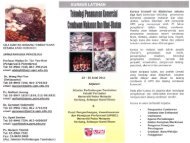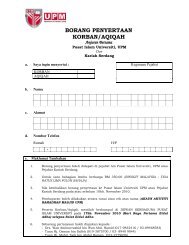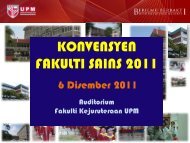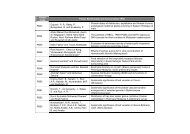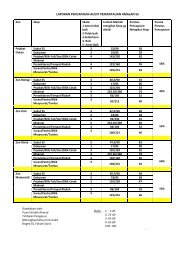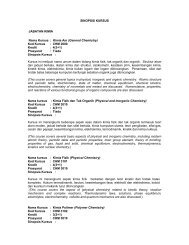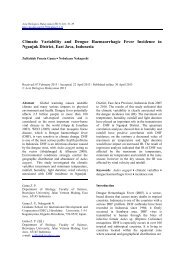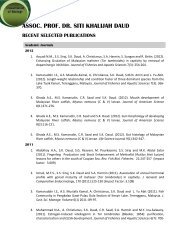Programme Book - UPM - Universiti Putra Malaysia
Programme Book - UPM - Universiti Putra Malaysia
Programme Book - UPM - Universiti Putra Malaysia
You also want an ePaper? Increase the reach of your titles
YUMPU automatically turns print PDFs into web optimized ePapers that Google loves.
P36PEDOT FORMATION IN AQUEOUS SOLUTIONSN.A. Mazelan, E.N. Ahmad, M.N. Rahiman, Y. Sulaiman*Department of Chemistry, Faculty of Science, <strong>Universiti</strong> <strong>Putra</strong> <strong>Malaysia</strong>, 43400 <strong>UPM</strong>Serdang, Selangor, <strong>Malaysia</strong>Corresponding author: yusran@science.upm.edu.myA study of electropolymerization of poly (3, 4-ethelenedioxythiophene) (PEDOT) thinfilm using chronopotentiometry technique in aqueous solution has been carried out inthe presence of various types of dopants and surfactants with different concentrations,times and current densities. The dopants used were bromide, chloride, iodine andperchlorate.The surfactants used include sodium dodecyl sulfate (SDS), triton-X andtetraethylammoniumtetraflouroborate (TEABF 4 ).The formation of PEDOT on theelectrode was confirmed by FTIR spectra obtained.The bands around 1197 and 1119cm −1 correspond to C-O-C asymmetric and symmetric stretching, respectively. Thesepeaks have shifted to higher (1294.65 cm −1 ) and lower (1023 cm −1 ) wavelengths in thepresence of surfactants. These shifting have confirmed strong interactions betweenPEDOT and surfactant molecules. Various morphologies such asgranular, needleshapedcrystals and compact morphology were observed when different dopants andsurfactants were used. The thickness of PEDOT films formed increased withincreasing the current densities and times.51 |16 th Industrial Chemistry Seminar: Chemistry- A Passport to a Brighter Future




